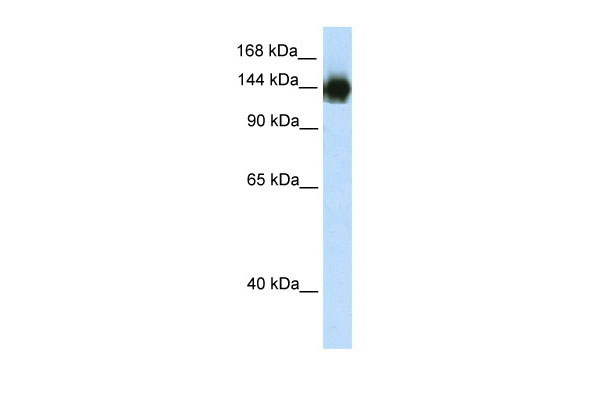TIMELESS antibody - N-terminal region
Rabbit Polyclonal Antibody
- SPECIFICATION
- CITATIONS
- PROTOCOLS
- BACKGROUND

Application
| WB |
|---|---|
| Primary Accession | Q9UNS1 |
| Other Accession | NM_003920, NP_003911 |
| Reactivity | Human, Mouse, Rat, Rabbit, Zebrafish, Pig, Sheep, Horse, Bovine, Dog |
| Predicted | Human, Mouse, Rat, Rabbit, Pig, Horse, Bovine, Dog |
| Host | Rabbit |
| Clonality | Polyclonal |
| Calculated MW | 139kDa |
| Gene ID | 8914 |
|---|---|
| Alias Symbol | TIM, TIM1, hTIM |
| Other Names | Protein timeless homolog, hTIM, TIMELESS {ECO:0000312|EMBL:AAH50557.1} |
| Format | Liquid. Purified antibody supplied in 1x PBS buffer with 0.09% (w/v) sodium azide and 2% sucrose. |
| Reconstitution & Storage | Add 100 ul of distilled water. Final anti-TIMELESS antibody concentration is 1 mg/ml in PBS buffer with 2% sucrose. For longer periods of storage, store at 20°C. Avoid repeat freeze-thaw cycles. |
| Precautions | TIMELESS antibody - N-terminal region is for research use only and not for use in diagnostic or therapeutic procedures. |
| Name | TIMELESS {ECO:0000312|EMBL:AAH50557.1} |
|---|---|
| Function | Plays an important role in the control of DNA replication, maintenance of replication fork stability, maintenance of genome stability throughout normal DNA replication, DNA repair and in the regulation of the circadian clock (PubMed:17141802, PubMed:17296725, PubMed:23359676, PubMed:23418588, PubMed:26344098, PubMed:31138685, PubMed:32705708, PubMed:35585232, PubMed:9856465). Required to stabilize replication forks during DNA replication by forming a complex with TIPIN: this complex regulates DNA replication processes under both normal and stress conditions, stabilizes replication forks and influences both CHEK1 phosphorylation and the intra-S phase checkpoint in response to genotoxic stress (PubMed:17141802, PubMed:17296725, PubMed:23359676, PubMed:35585232). During DNA replication, inhibits the CMG complex ATPase activity and activates DNA polymerases catalytic activities, coupling DNA unwinding and DNA synthesis (PubMed:23359676). TIMELESS promotes TIPIN nuclear localization (PubMed:17141802, PubMed:17296725). Plays a role in maintaining processive DNA replication past genomic guanine-rich DNA sequences that form G- quadruplex (G4) structures, possibly together with DDX1 (PubMed:32705708). Involved in cell survival after DNA damage or replication stress by promoting DNA repair (PubMed:17141802, PubMed:17296725, PubMed:26344098, PubMed:30356214). In response to double-strand breaks (DSBs), accumulates at DNA damage sites and promotes homologous recombination repair via its interaction with PARP1 (PubMed:26344098, PubMed:30356214, PubMed:31138685). May be specifically required for the ATR-CHEK1 pathway in the replication checkpoint induced by hydroxyurea or ultraviolet light (PubMed:15798197). Involved in the determination of period length and in the DNA damage-dependent phase advancing of the circadian clock (PubMed:23418588, PubMed:31138685). Negatively regulates CLOCK|NPAS2- ARTNL/BMAL1|ARTNL2/BMAL2-induced transactivation of PER1 possibly via translocation of PER1 into the nucleus (PubMed:31138685, PubMed:9856465). May play a role as destabilizer of the PER2-CRY2 complex (PubMed:31138685). May also play an important role in epithelial cell morphogenesis and formation of branching tubules (By similarity). |
| Cellular Location | Nucleus. Chromosome Note=In response to double-strand breaks (DSBs), accumulates at DNA damage sites via its interaction with PARP1 |
| Tissue Location | Expressed in all tissues examined including brain, heart, lung, liver, skeletal muscle, kidney, placenta, pancreas, spleen, thymus and testis. Highest levels of expression in placenta, pancreas, thymus and testis. |
If you have used an Abcepta product and would like to share how it has performed, please click on the "Submit Review" button and provide the requested information. Our staff will examine and post your review and contact you if needed.
If you have any additional inquiries please email technical services at tech@abcepta.com.














 Foundational characteristics of cancer include proliferation, angiogenesis, migration, evasion of apoptosis, and cellular immortality. Find key markers for these cellular processes and antibodies to detect them.
Foundational characteristics of cancer include proliferation, angiogenesis, migration, evasion of apoptosis, and cellular immortality. Find key markers for these cellular processes and antibodies to detect them. The SUMOplot™ Analysis Program predicts and scores sumoylation sites in your protein. SUMOylation is a post-translational modification involved in various cellular processes, such as nuclear-cytosolic transport, transcriptional regulation, apoptosis, protein stability, response to stress, and progression through the cell cycle.
The SUMOplot™ Analysis Program predicts and scores sumoylation sites in your protein. SUMOylation is a post-translational modification involved in various cellular processes, such as nuclear-cytosolic transport, transcriptional regulation, apoptosis, protein stability, response to stress, and progression through the cell cycle. The Autophagy Receptor Motif Plotter predicts and scores autophagy receptor binding sites in your protein. Identifying proteins connected to this pathway is critical to understanding the role of autophagy in physiological as well as pathological processes such as development, differentiation, neurodegenerative diseases, stress, infection, and cancer.
The Autophagy Receptor Motif Plotter predicts and scores autophagy receptor binding sites in your protein. Identifying proteins connected to this pathway is critical to understanding the role of autophagy in physiological as well as pathological processes such as development, differentiation, neurodegenerative diseases, stress, infection, and cancer.


